Ovarian cancer stem-like cells show induced translineage-differentiation capacity and are suppressed by alkaline phosphatase inhibitor
- PMID: 24280306
- PMCID: PMC3926833
- DOI: 10.18632/oncotarget.1424
Ovarian cancer stem-like cells show induced translineage-differentiation capacity and are suppressed by alkaline phosphatase inhibitor
Abstract
Spheroid formation is one property of stem cells-such as embryo-derived or neural stem cells-that has been used for the enrichment of cancer stem-like cells (CSLCs). However, it is unclear whether CSLC-derived spheroids are heterogeneous or whether they share common embryonic stemness properties. Understanding these features might lead to novel therapeutic approaches. Ovarian carcinoma is a deadly disease of women. We identified two types of spheroids (SR1 and SR2) from ovarian cancer cell lines and patients' specimens according to their morphology. Both types expressed stemness markers and could self-renew and initiate tumors when a low number of cells were used. Only SR1 could differentiate into multiple-lineage cell types under specific induction conditions. SR1 spheroids could differentiate to SR2 spheroids through epithelial-mesenchymal transition. Alkaline phosphatase (ALP) was highly expressed in SR1 spheroids, decreased in SR2 spheroids, and was absent in differentiated progenies in accordance with the loss of stemness properties. We verified that ALP can be a marker for ovarian CSLCs, and patients with greater ALP expression is related to advanced clinical stages and have a higher risk of recurrence and lower survival rate. The ALP inhibitor, levamisole, disrupted the self-renewal of ovarian CSLCs in vitro and tumor growth in vivo. In summary, this research provides a plastic ovarian cancer stem cell model and a new understanding of the cross-link between stem cells and cancers.This results show that ovarian CSLCs can be suppressed by levamisole. Our findings demonstrated that some ovarian CSLCs may restore ALP activity, and this suggests that inhibition of ALP activity may present a new opportunity for treatment of ovarian cancer.
Conflict of interest statement
The authors declare no potential conflicts of interest.
Figures
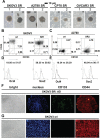

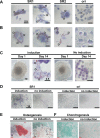
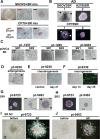
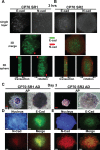
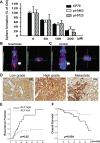
Similar articles
-
Enrichment of ovarian cancer stem-like cells is associated with epithelial to mesenchymal transition through an miRNA-activated AKT pathway.Cell Prolif. 2013 Aug;46(4):436-46. doi: 10.1111/cpr.12038. Cell Prolif. 2013. PMID: 23869765 Free PMC article.
-
S100B Mediates Stemness of Ovarian Cancer Stem-Like Cells Through Inhibiting p53.Stem Cells. 2017 Feb;35(2):325-336. doi: 10.1002/stem.2472. Epub 2016 Aug 21. Stem Cells. 2017. PMID: 27501952
-
Transformation of epithelial ovarian cancer stemlike cells into mesenchymal lineage via EMT results in cellular heterogeneity and supports tumor engraftment.Mol Med. 2012 Oct 24;18(1):1197-208. doi: 10.2119/molmed.2012.00075. Mol Med. 2012. PMID: 22801793 Free PMC article.
-
Cancer stem cells, epithelial-mesenchymal transition, and drug resistance in high-grade ovarian serous carcinoma.Hum Pathol. 2013 Nov;44(11):2373-84. doi: 10.1016/j.humpath.2013.05.001. Epub 2013 Jul 11. Hum Pathol. 2013. PMID: 23850493 Free PMC article. Review.
-
Ovarian cancer stem cells and inflammation.Cancer Biol Ther. 2011 Apr 15;11(8):708-13. doi: 10.4161/cbt.11.8.14967. Epub 2011 Apr 15. Cancer Biol Ther. 2011. PMID: 21317559 Free PMC article. Review.
Cited by
-
Developing ovarian cancer stem cell models: laying the pipeline from discovery to clinical intervention.Mol Cancer. 2014 Dec 11;13:262. doi: 10.1186/1476-4598-13-262. Mol Cancer. 2014. PMID: 25495823 Free PMC article. Review.
-
Enrichment for chemoresistant ovarian cancer stem cells from human cell lines.J Vis Exp. 2014 Sep 10;(91):51891. doi: 10.3791/51891. J Vis Exp. 2014. PMID: 25285606 Free PMC article.
-
TET1 reprograms the epithelial ovarian cancer epigenome and reveals casein kinase 2α as a therapeutic target.J Pathol. 2019 Jul;248(3):363-376. doi: 10.1002/path.5266. Epub 2019 Apr 23. J Pathol. 2019. PMID: 30883733 Free PMC article.
-
Epigenomic Profiling of Epithelial Ovarian Cancer Stem-Cell Differentiation Reveals GPD1 Associated Immune Suppressive Microenvironment and Poor Prognosis.Int J Mol Sci. 2022 May 4;23(9):5120. doi: 10.3390/ijms23095120. Int J Mol Sci. 2022. PMID: 35563509 Free PMC article.
-
CD133 Targeted PVP/PMMA Microparticle Incorporating Levamisole for the Treatment of Ovarian Cancer.Polymers (Basel). 2020 Feb 20;12(2):479. doi: 10.3390/polym12020479. Polymers (Basel). 2020. PMID: 32093199 Free PMC article.
References
-
- Valent P, Bonnet D, De Maria R, Lapidot T, Copland M, Melo JV, Chomienne C, Ishikawa F, Schuringa JJ, Stassi G, Huntly B, Herrmann H, Soulier J, Roesch A, Schuurhuis GJ, Wohrer S, et al. Cancer stem cell definitions and terminology: the devil is in the details. Nature reviews Cancer. 2012;12(11):767–775. - PubMed
-
- Vermeulen L, Sprick MR, Kemper K, Stassi G, Medema JP. Cancer stem cells--old concepts, new insights. Cell death and differentiation. 2008;15(6):947–958. - PubMed
-
- Bapat SA, Mali AM, Koppikar CB, Kurrey NK. Stem and progenitor-like cells contribute to the aggressive behavior of human epithelial ovarian cancer. Cancer Res. 2005;65(8):3025–3029. - PubMed
Publication types
MeSH terms
Substances
LinkOut - more resources
Full Text Sources
Other Literature Sources
Medical
Molecular Biology Databases
Research Materials

